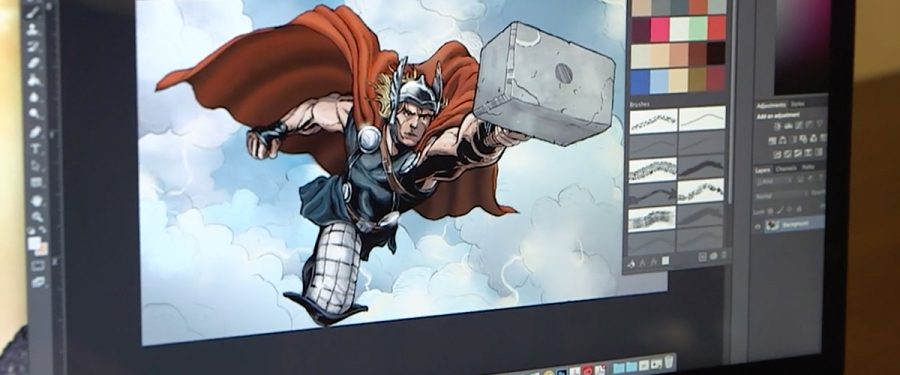Comic book art offers hero-worthy skills for VCD students
March 6, 2021
For advice on storytelling through comics, students can look to Assistant Professor Chad Lewis in the School of Visual Communication Design, who has created intellectual properties that include Marvel Comics.
Lewis’s career in comics began in Kent State’s graduate VCD program, where he won a contest to work for Marvel Comics in 2015.
Whether he’s sketching emblems onto the tunic of Marvel’s mighty god of thunder Thor or bringing Kong to life in the dubious mists of Skull Island, Lewis has a knack for artistic expression through comics.
Lewis presented his Thor comic as a two-page origin story of the Asgardian hero on a panel at San Diego Comic-Con.
In the creation of comics, the thought processes that go into it aren’t always considered. However, when viewers see the magic behind the curtain, a newfound appreciation might be discovered for the artist.
“When we read, we scan from top to bottom and left to right. What comics do that is amazing is that they tailor the story in the direction we read, so you can have a reader follow emotions and be surprised across a page,” Lewis said.
Bringing stories to life and grabbing the reader’s attention are key goals in the process of writing comics.
“You can manage the reader’s expectations, and to do so you need to be aware of cinematic camera angles and have a sure hold on perspective and anatomy so you can convince people in an average of three seconds, which takes bold storytelling and strong fundamentals,” he said.
Lewis brings his skills to the courses he began teaching in fall 2020 at Kent State’s VCD school.
“In his class, we learned about pushing the story through illustration. The facial expressions or even body language of the characters can tell just as much, if not more, than dialogue,” said Sarah Schwartz, a senior VCD student who took Lewis’s graphic narrative course.
Learning these skills applies directly to the career goals of students.
“My dream job is to be a concept artist for movies or even TV shows, and I think comic making is like a movie on paper,” Schwartz said. “Frame by frame, concept artists design the background of movies as well as the characters whether they are animated or live action, so I think comic making definitely impacts that.”
Student illustrators like Schwartz can hone their skills whether they are comic book connoisseurs or not through comic design.
“Comics can teach core principles that are useful for a wide range of areas,” said Daniel Alenquer, VCD’s director. “Not all students may be going into comics, but if they are going into something like character design for game design, I would definitely look at Chad Lewis’s work and say he could develop that in students.”
Austin Monigold covers CCI. Contact him at [email protected].












